SHRI SHIVAJI SCIENCE COLLEGE, AMRAVATI
DBT STAR COLLEGE PROJECT ACTIVITY
ACTIVITY REPORT
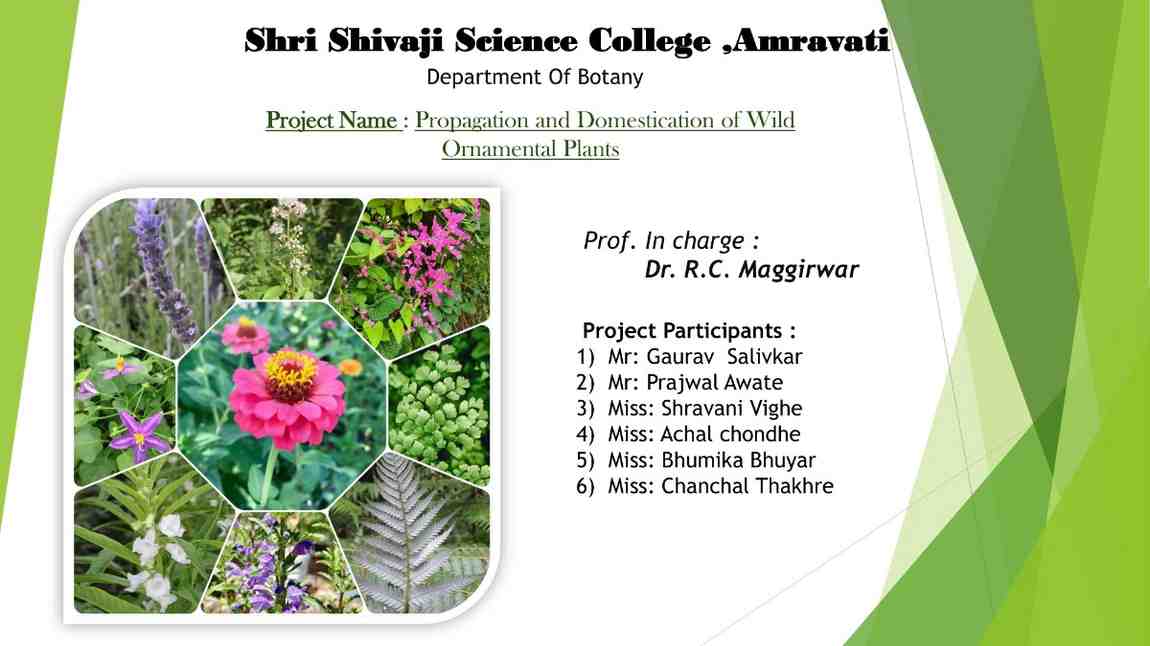
Propagation and Domestication of Wild Ornamental Plants
Activity Dates: 27/09/2024
Type of Activity: Minor Research Project
Organizing Department: Department of Botany & Bioinformatics
Program Coordinators: Dr. R. C. Maggirwar
Head of the Department: Dr. D. D. Khedkar
External Collaborator (if any): Dr. G.D. Muratkar, Professor Department of Environment Science, Arts, Commerce and Science College, Chikhaldara
Objectives:
- Identification of Wild Ornamental Species: To explore and identify wild plants in Melghat that possess ornamental value and can be utilized for ex situ conservation.
- Understanding Ecological Adaptations: To study the ecological adaptations of wild plants, gaining insight into their growth habits and environmental needs for potential domestication.
- Learning Propagation Techniques: To learn about suitable propagation methods, including seed germination and vegetative techniques, for successful cultivation of wild ornamental species.
- Ex situ Conservation Strategies: To explore the role of ex situ conservation in preserving biodiversity through domestication of wild plants for ornamental use in gardens and landscapes.
- Skill Development in Horticulture: To provide students with practical exposure to horticultural practices that support the domestication of wild ornamental plants, enhancing their skill sets in sustainable plant management.
No of Beneficieries: 06
Classes Involved: B. Sc. III Bio
Venue of the Activity: Melghat Tiger Reserve,Madki to Chikhaldara • Paratwada territorial forest area • Gawvilgarh Range , MTR , Buffer forest area
Activity Report:
As part of the final year curriculum for the B.Sc. Biology students at Shri Shivaji Science College, Amravati, a field visit was organized to Melghat Tiger Reserve on September 27, 2024. The visit aimed to introduce students to the Propagation and Domestication of Wild Ornamental Plants, with a specific focus on identifying and collecting wild plant species that hold potential for ornamental use. This field activity aligns with the broader goals of ex situ conservation and sustainable plant management. The students were privileged to have the guidance of Dr. Gajanan Muratkar, an expert in environmental science, known for his extensive work in grassland conservation and biodiversity. He played a pivotal role in leading the students through the jungle, helping them identify 30 wild plant species suitable for propagation and domestication.
Journey to Melghat Tiger Reserve
The students departed early in the morning from Shri Shivaji Science College to reach Melghat Tiger Reserve, a key biodiversity hotspot in Maharashtra. Situated in the Satpura Range, Melghat is renowned for its ecological diversity and is home to a variety of flora and fauna. The students were excited and eager to explore the rich natural landscape, which has been a center for wildlife and plant conservation for decades.
Upon arrival, the students were briefed on the plan for the day, safety precautions, and key learnings expected from the field trip. Dr. Gajanan Muratkar set the tone for the day, inspiring students with stories of his work in grassland and plant conservation. He emphasized the role that young biologists can play in conserving India’s biodiversity.
Plant Identification and Collection
The core activity of the field visit was focused on the identification and collection of wild plants that hold ornamental value. Under Dr. Muratkar's expert guidance, the students explored the forests of Melghat and identified in total 30 wild plant species that can be domesticated for ornamental use. Some of the plants identified during the tour were species native to the Satpura region and known for their aesthetic value.
Dr. Muratkar taught the students about the ecological significance of each plant and how its unique adaptations allow it to survive in the wild. By understanding these adaptations, the students gained insight into how these plants could be nurtured and propagated in artificial environments such as gardens, parks, and homes. The process of selecting plants was based on criteria such as resilience, aesthetic value, ease of propagation, and ecological adaptability to new environments.
Biodiversity and Conservation Insights
During the exploration, the students also had the opportunity to observe the broader biodiversity of the Melghat Tiger Reserve. From towering trees to rare grass species, the students saw how these plants contribute to the ecosystem and support a variety of wildlife. Dr. Muratkar emphasized the importance of conserving this biodiversity, not only for its ecological value but also for the benefits it can provide in terms of aesthetic and medicinal uses.
Students learned about the importance of biodiversity for maintaining ecological balance and how human activities such as deforestation, climate change, and urbanization threaten these natural resources. Dr. Muratkar stressed the need for more concerted efforts towards conservation, and how young scientists can make meaningful contributions through research and practical efforts such as nursery development and plant propagation.
Sites of Floral specimen collection:
Madki to Chikhaldara
• Paratwada territorial forest area
• Gawvilgarh Range , MTR , Buffer forest area
Time : 9.45 am to 1.0 pm
Soil : red , acidic
Average rainfall : 1200 mm
Temperature : 23-to 27 degree celcious
Humidity : 65-78%
Wind speed : 35 -56 km / hr
Sr. No. Scientific Name Common name Family Location Mode of propagation Habitat Ecological importance
1 Anisochilus carnosus Wall. Pl. Kapuri Lamiaceae Near madki , hari ambary water fall By seeds Moist places along water Indicator of high altitude , flowers pale purple, litho phytic growing on moist rocky areas
2 Apluda mutica Moti tura Poaceae Madki road Seeds Shade tolerant Grass of shady area with red root branches
3 Indigofera linifolia Legumes Leguminosae On road side Seeds Open sunlight Biological nitrogen fixator , natural dye yielding
4 Phaseolus radiates Udid Leguminosae On road side madki road Seeds Open sunlight Wild relative of leguminous plan , udid
5 Glycine max Wild soyabean Leguminosae On road side madki road Seeds Open sunlight Wild relative of leguminous plan , udid
6 Cymbopogon martinee Rosha , tikhali Poaceae Madki village on rocky area Seeds , rhizomes Open grassland , hard soil Oil yielding aromatic grass , oil base of perfumes.
7 Pogostemon plectranthoides Desf.. in. Mem. Pogostemon Lamiaceae Sipna college road to HVPM road Seeds Shady areas Best bee flora , ecological indicator of high altitude , rainfall , humidity , acidic soil , shade , canopy.
8 Cheilanthus albomarginata Silver fern Polipodiaceae Rocky fern near Motha wind mill Sori Shady fern Indicator of high humidity, rainfall , latitude
9 Adiantum lunulatum Lunar fern Adiantaceae Moist soil fern near Alladoh Sori Shady fern Ecological Indicator of high humidity, rainfall , latitude
10 Actinopteris radiata Rock fern Actinopteridaceae Near hari ambrai water flow area on shady rocks Sori Shady , rocky areas Lithophytic shady fern
11 Stachytarpeta indica Vahl.
S. jamaicensis Vahl. Verbenaceae Chikhaldara platue Seeds Red soil in open areas Ecological indicator of high altitude , rainfall , humidity .
12 Thunbergia allata Clockvines Acanthaceae Sipna college campus , forest garden Seeds , stolons Climber in moist places Ecological indicator of high altitude
13 Antigonon leptopus Mexican creeper Polygonaceae Garden forest areas Cuts , vegetative and seeds Open area climber woody Inflorescence attractive purple flowers
14 Clerodendron multiflorum Khaduchakka Verbenaceae Govt forest garden area Seeds Shady species/ shade tolerant Bee flora , Medicinal plant
15 Clerodendron exacum Seeds Shady species/ shade tolerant
16 Achanthospermum hispida Acanthaceae Upper platue chikhaldara Seeds Shady species/ shade tolerant Shady , ornamental wild plant.
17 Dioscorioa tuberosa Babra Dioscoeaceae Upper platue near HVPM chikhaldara Bulbs , tubers Shady species/ shade tolerant Tuberous plant , climber
18 Clematis recta Ran Jai Ranunculaceae Chikhaldara forest road Seeds , cuts at nodes Shady species/ shade tolerant woody climber Woody climber of high altitude
19 Barleria cristata Kate korantee Acanthaceae Madki village Seeds shade tolerant Forest species with purple – blue flowers
20 Impatiens balsamia Balsam / impatiens Acanthaceae Chikhaldara road near madki village Seeds shade tolerant Ecological indicator of high altitude
21 Lavandula burmani lavender Lamiaceae Madki village road Seeds Rocky areas Aromatic rocky flora
22 Bignonia unguis cati Bignonia Bignoniaceae Forest garden road Vegetative propagation Shady species/ shade tolerant woody climber Woody hooks climber
23 Athyrium pectinatum Fern Athyriaceae Near Barmasati Alladoh. Sori Shady species/ shade tolerant Fern at high altitude
24 Athyrium debatum Fern Athyriaceae Near Barmasati Alladoh. Sori Shady species/ shade tolerant Fern at high altitude
25 Solanum insanum Wild brinjal Solanaceae Near HVPM campus Seeds Shady species/ shade tolerant High altitude plant with spines flowers white / blue
26 Oxalis corniculata Wild brahmi Umbelliferae /Apiaceae Near wind mill Stolons Shady species/ shade tolerant moist areas Shady runner with stlons
27 Celosia argentiana Kombada Acanthaceae Near madki village Seeds Open area Butterfly flora
28 Sida alba Wild sida Malvaceae Madki platue Seeds Open area Wild white flowers
29 Costus speciosus Wild ginger Zingiberaceae Alladoh rhizomes Grows in shade White flowers , perennial
30 Curcuma amada Ambe haladi Zingiberaceae Alladoh rhzoimes Shady , grows in red murmi soil Perennial medicinal
Skills Gained: Nursery Creation and Horticulture
One of the significant educational aspects of this field trip was the practical exposure to nursery creation and horticultural skills. Dr. Muratkar guided students on the steps involved in developing a plant nursery, from seed collection and germination techniques to transplanting and growing the plants in a controlled environment. These skills are crucial for students who wish to pursue careers in botany, horticulture, or environmental conservation.
The hands-on experience provided by the field visit helped students understand how to propagate wild ornamental plants in a way that ensures their survival and growth in new environments. Learning nursery management also gave the students an understanding of plant care, pest management, soil preparation, and irrigation—skills essential for cultivating healthy plants.
Economic Benefits through Conservation
An important theme discussed during the visit was the potential economic benefits of plant propagation and domestication. Dr. Muratkar highlighted how students could take the knowledge gained from the field trip and apply it to create nurseries of wild ornamental plants. These plants, once conserved and propagated, can be sold in markets, providing students with a means of income while contributing to nature conservation. By promoting the cultivation of native species, students can play a role in reducing the demand for exotic plants that may be invasive or unsustainable.
Dr. Muratkar also encouraged the students to think beyond traditional careers and explore entrepreneurial avenues within the field of environmental conservation. He explained how plant nurseries not only serve as conservation tools but also provide opportunities for sustainable livelihoods through the sale of plants for landscaping, home gardens, and public spaces.
Reflections and Future Opportunities
The field visit concluded with a reflection session where students shared their experiences and the knowledge they gained during the day. Many students expressed how eye-opening it was to see the diversity of plant life in its natural habitat and how they now felt motivated to contribute to conservation efforts. Some expressed interest in setting up their own nurseries, while others were keen to explore research opportunities in plant propagation and conservation biology.
The visit to Melghat Tiger Reserve was a pivotal learning experience for the students, offering them practical knowledge and hands-on experience in plant identification, conservation, and propagation. The project on the Propagation and Domestication of Wild Ornamental Plants will continue, with students applying the skills they learned to create nurseries and work toward the ex situ conservation of the species they collected.
Conclusion
This field visit provided a unique opportunity for students to merge theoretical knowledge with practical skills in plant conservation. The guidance of Dr. Gajanan Muratkar was instrumental in helping the students gain a deep understanding of the significance of propagating and domesticating wild plants for ornamental purposes. This educational experience not only fostered a greater appreciation for biodiversity but also opened doors for students to explore conservation-based entrepreneurship, making this field trip a crucial step in their academic and personal growth.
Outcomes:
- Successful Identification of Wild Ornamental Plants: Students identified and collected 30 wild plant species from Melghat Tiger Reserve that have the potential to be domesticated for ornamental use, contributing to biodiversity preservation through ex situ conservation.
- Skill Development in Nursery Management: Students gained practical skills in nursery creation, plant propagation, and horticultural techniques, enabling them to cultivate wild plants in controlled environments and foster a deeper understanding of plant care.
- Enhanced Knowledge of Biodiversity and Conservation: The field visit helped students understand the significance of preserving biodiversity, with a focus on conservation strategies for native plant species and the ecological importance of wild plants.
- Economic Opportunities through Conservation: The project introduced students to the potential of earning income by cultivating and selling domesticated ornamental plants, combining entrepreneurial ventures with conservation efforts.
- Contribution to Ex Situ Conservation Efforts: By propagating wild ornamental plants in nurseries, students contributed to ex situ conservation, helping to safeguard plant species outside their natural habitats and promote sustainable practices in horticulture and landscaping.
Photos:
 Students exploring the rich biodiversity of Melghat Tiger Reserve. |  Dr. Gajanan Muratkar shares his knowledge on identifying wild ornamental plants. |
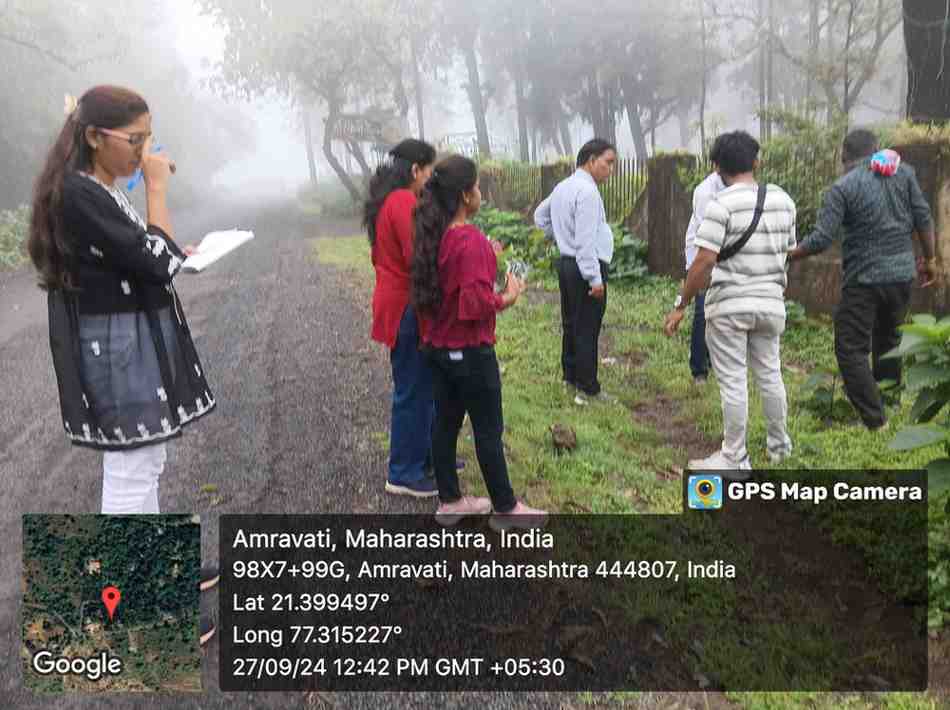 Documenting the 30 wild plants identified for ornamental propagation. | 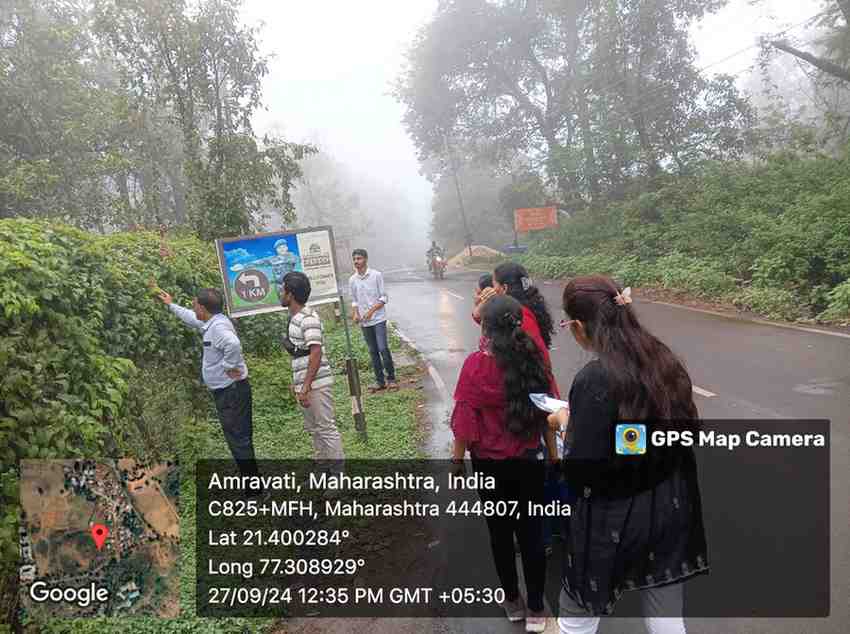 Students immerse themselves in the natural beauty of Melghat's landscapes. |
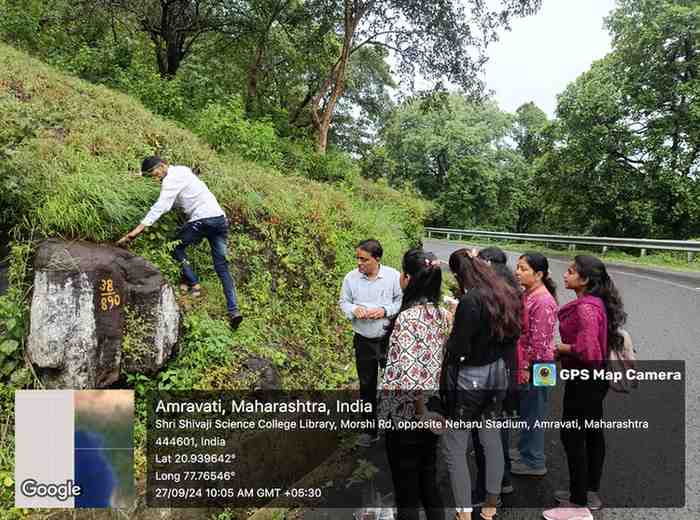 Students carefully collecting wild plant species for ex situ conservation | 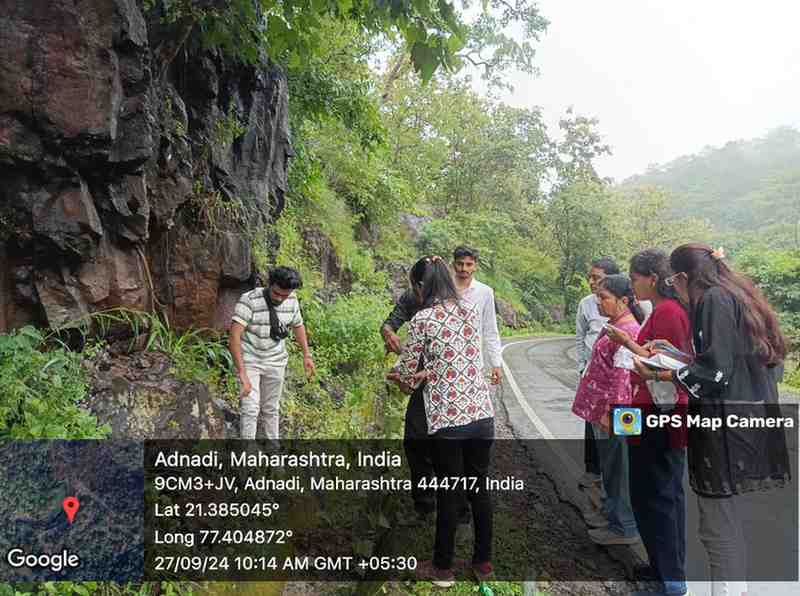 Nature's Classroom |
Attendance Sheet:
 |